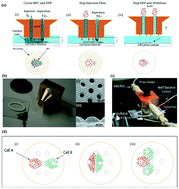Our official English website, www.x-mol.net, welcomes your
feedback! (Note: you will need to create a separate account there.)
Microelectrofluidic probe for sequential cell separation and patterning.
Lab on a Chip ( IF 6.1 ) Pub Date : 2019-10-22 , DOI: 10.1039/c9lc00748b Ayoola T Brimmo 1 , Anoop Menachery 2 , Mohammad A Qasaimeh 1
Lab on a Chip ( IF 6.1 ) Pub Date : 2019-10-22 , DOI: 10.1039/c9lc00748b Ayoola T Brimmo 1 , Anoop Menachery 2 , Mohammad A Qasaimeh 1
Affiliation

|
Cell separation and patterning are of interest to several biological and medical applications including rare cell isolation and co-culture models. Numerous microfluidic devices have been used for cell separation and patterning, however, the typical closed channel configuration comes with challenges and limitations. Here, we report a dielectrophoresis (DEP) enabled microelectrofluidic probe (MeFP) for sequentially separating and patterning of mammalian cells in an open microfluidic system. The MeFP is a microfluidic probe with injection and aspiration apertures, integrated with an array of micro-hump electrodes on its tip. Aligning the MeFP parallel, and in close proximity, to a conductive substrate forms a vertical pin-plate electrode configuration that allows for an integration of DEP forces within the hydrodynamic flow confinement. Upon confining a heterogeneous cell suspension in the gap between the MeFP and the substrate, target cells are selectively captured on the micro-hump electrodes using positive DEP forces, and then deposited on the substrate in defined patterns. Characterization of the MeFP showed an increase in cell-capture efficiency when the MeFP is of a higher microfluidic multipole configuration. Separation of cancer cells from T lymphocytes was demonstrated with capture purity as high as 89.6%. Deposited patterns of isolated cells match the numerically calculated particle trajectories of the evaluated microfluidic multipoles configurations. By adjusting the flow configuration of the MeFP, we show that the patterned co-culture of two different cell types can be dynamically controlled for homotypic and heterotypic cell interaction studies. This work presents a multifunctional microfluidic tool that bio-fabricates selective multicellular patterns directly on an open substrate without the need for confined conduits.
中文翻译:

微电探针用于顺序细胞分离和图案化。
细胞分离和模式化是几种生物学和医学应用所关注的,包括稀有细胞分离和共培养模型。许多微流体装置已经用于细胞分离和图案化,但是,典型的封闭通道配置具有挑战性和局限性。在这里,我们报告了介电电泳(DEP)启用的微电流体探针(MeFP),用于在开放的微流系统中依次分离和模式化哺乳动物细胞。MeFP是一种具有注射孔和抽吸孔的微流体探针,在其尖端集成了一系列微峰电极。将MeFP与导电基板平行并紧密对齐,形成垂直的针板电极配置,该配置可将DEP力整合到流体动力约束中。在将异质细胞悬浮液限制在MeFP与基板之间的间隙中后,使用正DEP力将靶细胞选择性地捕获在微驼峰电极上,然后以定义的模式沉积在基板上。当MeFP具有更高的微流多极配置时,MeFP的表征显示细胞捕获效率的提高。证明了癌细胞与T淋巴细胞的分离,捕获纯度高达89.6%。分离细胞的沉积模式与评估的微流体多极构型的数值计算的粒子轨迹相匹配。通过调整MeFP的流动配置,我们表明可以动态控制两种不同细胞类型的模式共培养,以进行同型和异型细胞相互作用研究。
更新日期:2019-12-04
中文翻译:

微电探针用于顺序细胞分离和图案化。
细胞分离和模式化是几种生物学和医学应用所关注的,包括稀有细胞分离和共培养模型。许多微流体装置已经用于细胞分离和图案化,但是,典型的封闭通道配置具有挑战性和局限性。在这里,我们报告了介电电泳(DEP)启用的微电流体探针(MeFP),用于在开放的微流系统中依次分离和模式化哺乳动物细胞。MeFP是一种具有注射孔和抽吸孔的微流体探针,在其尖端集成了一系列微峰电极。将MeFP与导电基板平行并紧密对齐,形成垂直的针板电极配置,该配置可将DEP力整合到流体动力约束中。在将异质细胞悬浮液限制在MeFP与基板之间的间隙中后,使用正DEP力将靶细胞选择性地捕获在微驼峰电极上,然后以定义的模式沉积在基板上。当MeFP具有更高的微流多极配置时,MeFP的表征显示细胞捕获效率的提高。证明了癌细胞与T淋巴细胞的分离,捕获纯度高达89.6%。分离细胞的沉积模式与评估的微流体多极构型的数值计算的粒子轨迹相匹配。通过调整MeFP的流动配置,我们表明可以动态控制两种不同细胞类型的模式共培养,以进行同型和异型细胞相互作用研究。











































 京公网安备 11010802027423号
京公网安备 11010802027423号